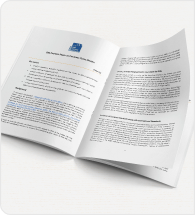➢ Background
This paper considers the case of fire protective products and the characteristic resistance to fire only (a characteristic requiring notified body certification and which is under the Construction Products Regulation (CPR)). The principles and recommendations, however, may be extended to other fire performance characteristics and to products requiring notified body testing.
An increasing number of restrictions on which bodies may undertake the writing of Extended Application (EXAP) and fire classification reports are being written into CEN standards and guidance from the Group of Notified Bodies (GNB), limiting the body able to write such reports to the one which performed initial type testing. SBS considers such restrictions to be unacceptable, as they disproportionately discriminate against SMEs which do not have the equipment required to perform initial type tests.
Recommendation
SBS asks the Standing Committee on Construction (SCC) to clarify that suitably qualified bodies shall be permitted to write EXAP and fire classification reports, and that no restrictions are written into CEN standards that limit the ability of such bodies to do this.
➢ Current practice and limitations
Resistance to fire of construction products is demonstrated through the classification of the product in accordance with the classification standard EN 13501-2. Fire protection products are under Assessment and Verification of Constancy of Performance (AVCP) System 1, meaning that a notified product certification body (NPCB) takes overall responsibility for AVCP tasks.
Current practice is that a fire test laboratory (which may be a part of the NPCB or act as a subcontractor to it) performs an initial resistance to fire test. The results come with a direct field of application (the extent to which the results apply to products and installation conditions different from those tested) as given in the appropriate fire test standard.
Because of the cost of fire testing, the field of application is often widened using EXAP. EXAP reports are judgements made on the applicability of the test results to a range of products/applications beyond those in the direct field of application. They are based on rules laid down within EXAP standards published by CEN, or EXAP procedures within EADs published by EOTA. Once an EXAP report has been written, a fire classification report is produced, stating which class(es) of fire resistance are applicable to which product(s) and application(s).
According to the Fire Sector Group (FSG) of the GNB Recommendation 002 Rev 2, the EXAP report and the resistance to fire classification report shall be written by the fire test laboratory. This
requirement/limitation is also written into various fire standards.
An example of the restriction on the production of EXAP reports comes from EN 15725:2010, 5.3
Extended field of application:
“Extended application shall be undertaken by the laboratory which has carried out the relevant fire tests.”
A similar restriction on fire classification reports may be inferred from positions taken by the FSG (source: GNB-CPR Guidance Base document):
-Which notified bodies can issue classification reports on reaction to fire, resistance to fire, and external fire exposure?
-A classification report is based on the results of one or more tests. To ensure coherence between the testing and classification, it is recommended that classification reports are drawn up by the laboratory conducting the tests. Consequently, notified bodies should only draw up classification reports on the basis of testing conducted fully or partially by themselves, unless otherwise justified by extraordinary circumstances. Certification bodies subcontracting the testing should also subcontract the drawing up of the classification report to the same laboratory (or laboratories).
➢ The negative impact on SMEs
The current restrictions, which limit the production of EXAP and classification reports to test laboratories, harm SME bodies. SMEs are less likely to have their own test laboratories (more likely to work in conjunction with accredited third-party test laboratories), but they do possess the knowledge and experience to produce EXAP and classification reports.
SBS seeks clarification that EXAP and classification reports can be issued by suitably-qualified bodies, without restrictions based on involvement in initial type testing or the ownership of specific test equipment. Any restrictions to the contrary limit the ability to offer professional services and distort competition within the European single market. They also disproportionately discriminate against SMEs active in this area.
➢ Justification for objections
SBS recognises the need to ensure competence among the bodies issuing EXAP and classification reports. However, the current restrictions do not necessarily achieve this, and are certainly introducing a barrier to a trade in professional services.
SBS makes the following points in support of this objection:
• According to CPR Annex V, laboratories are defined as bodies notified to “measure, examine, test, calculate or otherwise assess the performance of construction products”. There is no distinction within the CPR between a test laboratory and a calculation body.
• The responsibility for issuing a product certificate for fire protection products (of AVCP System 1) lies with the NPCB. Within an organisation that is both a product certification body and a test laboratory, accreditation requires that it is structured in a way that ensures a separation between these two functions. In the majority of cases, the personnel conducting fire tests and those assessing or interpreting the results are different.
• Test results are recorded by necessity, and by requirements of EN 17025 can be made available to third parties at the request of the test sponsor. Arguments that information is available only within the original test laboratory are invalid, because test standards determine what information is necessary for adequate interpretation of test results and require adequate reporting.
• Test laboratories do not automatically contain the expertise to generate extended application reports. The expertise required to conduct a fire test and to interpret the results is different. It should therefore be possible for SME bodies specialised in EXAP to be able to offer their services even if they have not performed the test.
➢ Summary
SBS recognises the requirement for EXAP reports to be written only by bodies with sufficient competence. The current restrictions, implemented by GNB positions and CEN standards, though, do not provide this assurance of competence and introduce a restriction that disproportionately disadvantages competent SMEs.
SBS proposes that competence be defined in terms of experience and/or qualifications. Defining it by test equipment or employer, as the current situation requires, is an inappropriate restriction of trade in professional services.
SBS requests endorsement of this position paper from the European Commission, and its circulation to CEN TC127, Fire safety and the Group of Notified Bodies.



























